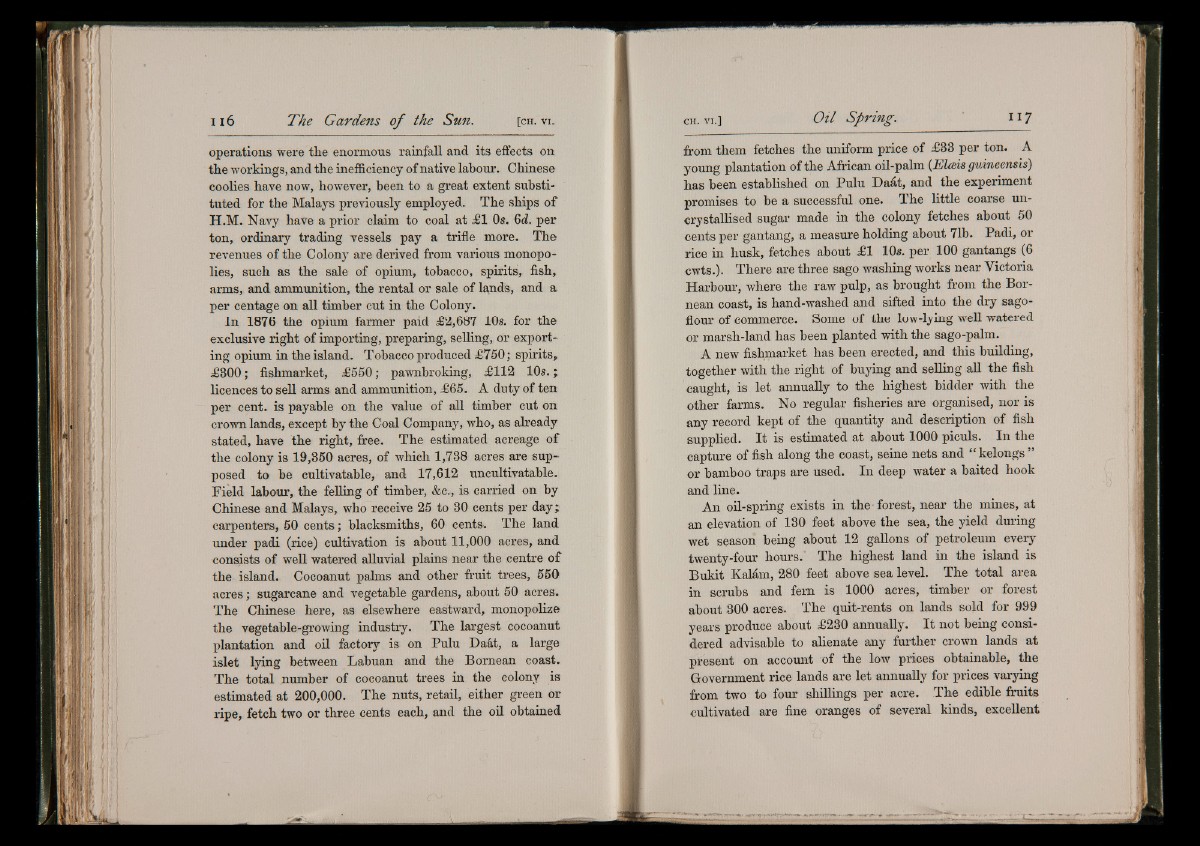
operations were the enormous rainfall and its effects on
the workings, and the inefficiency of native labour. Chinese
coolies have now, however, been to a great extent substituted
for the Malays previously employed. The ships of
H.M. Navy have a prior claim to coal at ¿61 Os. 6d. per
ton, ordinary trading vessels pay a trifle more. The
revenues of the Colony are derived from various monopolies,
such as the sale of opium, tobacco, spirits, fish,
arms, and ammunition, the rental or sale of lands, and a
per centage on all timber cut in the Colony.
In 1876 the opium farmer paid ¿62,687 10s. for the
exclusive right of importing, preparing, selling, or exporting
opium in the island. Tobacco produced ¿6750; spirits,
£300; fishmarket, ¿6550; pawnhroking, £112 10s.;
licences to sell arms and ammunition, £65. A duty of ten
per cent, is payable on the value of all timber cut on
crown lands, except by the Coal Company, who, as already
stated, have the right, free. The estimated acreage o f
the colony is 19,350 acres, of which 1,738 acres are supposed
to be cultivatable, and 17,612 uncultivatable.
Field labour, the felling of timber, &c., is carried on by
Chinese and Malays, who receive 25 to 30 cents per day;
carpenters, 50 cents; blacksmiths, 60 cents. The land
under padi (rice) cultivation is about 11,000 acres, and
consists of well watered alluvial plains near the centre of
the island. Cocoanut palms and other fruit trees, 550
acres; sugarcane and vegetable gardens, about 50 acres.
The Chinese here, as elsewhere eastward, monopolize
the vegetable-growing industry. The largest cocoanut
plantation and oil factory is on Pulu Daat, a large
islet lying between Lahuan and the Bornean coast.
The total number of cocoanut trees in the colony is
estimated at 200,000. The nuts, retail, either green or
ripe, fetch two or three cents each, and the oil obtained
from them fetches the uniform price of £33 per ton. A
young plantation of the African oil-palm (Elceis guineensis)
has been established on Pulu Daat, and the experiment
promises to he a successful one. The little coarse uncrystallised
sugar made in the colony fetches about 50
cents per gantang, a measure holding about 71b. Padi, or
rice in husk, fetches about £ 1 10s. per 100 gantangs (6
cwts.). There are three sago washing works near Victoria
Harbour, where the raw pulp, as brought from the Bornean
coast, is hand-washed and sifted into the dry sago-
flour of commerce. Some of the low-lying well watered
or marsh-land has been planted with the sago-palm.
A new fishmarket has been erected, and this building,
together with the right of buying and selling all the fish
caught, is let annually to the highest bidder with the
other farms. No regular fisheries are organised, nor is
any record kept of the quantity and description of fish
supplied. It is estimated at about 1000 piculs. In the
capture of fish along the coast, seine nets and “ kelongs ”
or bamboo traps are used. In deep water a baited hook
and line.
An oil-spring exists in the forest, near the mines, at
an elevation of 130 feet above the sea, the yield during
wet season being about 12 gallons of petroleum every
twenty-four hours.' The highest land in the island is
Bukit Kalam, 280 feet above sea level. The total area
in scrubs and fern is 1000 acres, timber or forest
about 300 acres. The quit-rents on lands sold for 999
years produce about £230 annually. It not being considered
advisable to alienate any further crown lands at
present on account of the low prices obtainable, the
Government rice lands are let annually for prices varying
from two to four shillings per acre. The edible fruits
cultivated are fine oranges of several kinds, excellent